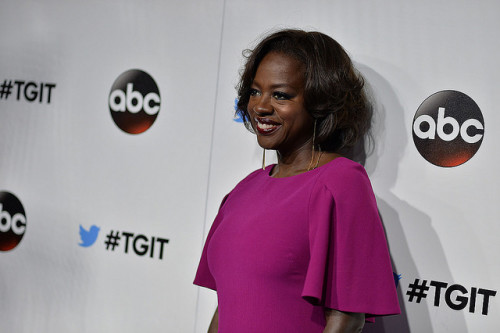This guest post by Corinne Gaston previously appeared at the Ms. blog and is cross-posted with permission.
After the weeks of hype and speculation leading up to the premiere, How to Get Away with Murder has been the show to watch on Thursday nights. Viola Davis stars as Annalise Keating, a law school professor and criminal defense attorney, whom you can tell from the get-go is not a person to be crossed.
She expects 100 percent from her students when she walks into Middleton Law School’s Criminal Law 101–or, as she likes to call the class, How to Get Away with Murder. Their first assignment? Come up with a defense for the attempted murder case she is working on. The only catch is that not one of the dozens upon dozens of students can repeat another student’s idea. She takes these students under her wing but she does not mother them; after all, the business of defending criminals is a hard one.
While many have praised Davis’ characterization of Keating, others, such as The New York Times critic Alessandra Stanley, boxed-in Keating as an “Angry Black Woman” before a single episode of the show had even aired. Keating was portrayed as “strong” and confident in the show’s trailer, which was enough for some folks to write her off. But in the pilot we see her actual character, and from the second she steps in front of the camera she is a force to be reckoned with. Keating’s gaze is unflinching and penetrating, her voice unwavering and, I must admit, I found her character to be menacing. But that does not obscure her creativity, brilliance and charisma. She openly expresses anger, dissatisfaction, sexuality and high expectations, and it should go without saying that stereotyping her would be a huge misstep.
Given the relative lack of diversity on television, particularly with show leads, characters like Davis’ Keating already have the limited representation of Black women in television (and film) working against them—it leads to extra pressure to “represent” or act as “spokespeople” for Black women, even if that is an unfair expectation. But then the double whammy comes in the form of racial biases. If you’re a Black woman actor and your character is too sexual? Jezebel. Cares too much for others? Mammy. Loud or expressive? Ratchet. Reveals any emotion that can be linked to displeasure OR (and here’s the kicker) personal standards? Angry Black Woman.
Not only does this kind of stereotyping delegitimize Black women’s feelings, but it functions as a racist and misogynistic social policing tactic that pressures black women to self-censor their opinions, feelings and needs, or else be written off as a “type.” In fictional representations, the Angry Black Woman labeling and policing limits the types of black women we see in film, literature, comics, television, and other media.
Despite the public criticisms that are sure to arise over Davis’ character—that she is too tough or aggressive—I am personally thankful that her character exists and that Davis plays Keating the way she does. It’s not often you see a Black woman character exude so much fearsome, respected power and confidence and not be portrayed as an over-the-top Sapphire stereotype, like many of the women in Tyler Perry’s movies. She is a hard, dynamic, and mysterious person. However, she does have her moment of vulnerability when one of her students finds her crying over the state of her strained marriage–because, of course, she’s human.
Oftentimes it feels like writers, producers and directors are afraid to show truly complex depictions of Black women for fear that audiences will not accept them. Which is funny, because white men are given huge amounts of freedom to depict complex, questionable and even immoral protagonists. Beyond that, these white male characters are often praised, loved and lionized—all without being written off as Angry White Men (even when they are very, very angry). Characters like Walter White from Breaking Bad and Dexter Morgan from Dexter, for example, amassed huge fan followings, even though one is a meth kingpin and the other is a straight-up murderer.
White male television characters can be crime bosses, murderers, meth manufacturers, drug dealers, drug users and thieves and be lauded, while in real life some of those identities (such as drug user and thief) have been used to dehumanize Black individuals and argue away their murders. Clearly there’s a racial representation issue that goes deeper than television, but as it stands, Black women actors should have the freedom to play as complex and troubling characters as white men and have their acting expertise applauded.
The first episode of How to Get Away with Murder laid the groundwork for twisting story lines to come: murder, affairs and, of course, more murder. If the plot line follows the path I think it will, the second murder, supposedly committed by four of Keating’s students, will be discovered, the four will go to trial and Keating will end up either defending or prosecuting her very own students. The show has the flexibility to go in many directions and so does Annalise Keating, who doesn’t tolerate the word “failure” in her personal dictionary, but will be forced to reckon with her own secrets.
At this point, I don’t know much of who she is, to which side her complex character skews in terms of general morals, or even if I’m rooting for her yet in the storyline. What I am rooting for, however, is her existence.
Corinne Gaston is an editorial intern at Ms. Follow her on Twitter @elysehamsa or go to her personal blog.





